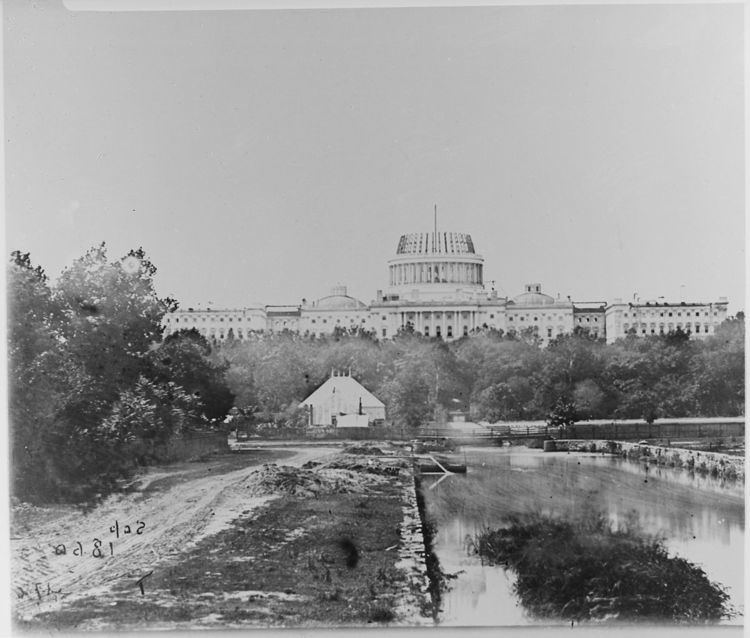The Thirty-fifth United States Congress was a meeting of the legislative branch of the United States federal government, consisting of the United States Senate and the United States House of Representatives. It met in Washington, D.C. from March 4, 1857 to March 4, 1859, during the first two years of James Buchanan's presidency. The apportionment of seats in the House of Representatives was based on the Seventh Census of the United States in 1850. Both chambers had a Democratic majority.
Panic of 1857March 4, 1857. James Buchanan became President of the United StatesMarch 6, 1857: Dred Scott v. SandfordJuly 18, 1857: Utah Expedition left Fort Leavenworth, effectively beginning the Utah WarAugust 21, 1858: First of the Lincoln-Douglas debates was heldMarch 3, 1859: Financial appropriations for the improvement and construction of lighthouses.March 12, 1858: Treaty with the Ponca signedApril 19, 1858: Treaty with the Yankton Sioux signedJuly 29, 1858: Harris Treaty signed with JapanMay 11, 1858: Minnesota admitted as the 32nd stateFebruary 14, 1859: Oregon admitted as the 33rd stateDuring this congress, two Senate seats were added for each of the new states of Minnesota and Oregon.
During this congress, two House seats were added for the new state of Minnesota and one House seat was added for the new state of Oregon.
President: John C. Breckinridge (D)President pro tempore: James M. Mason (D), March 4, 1857 onlyThomas J. Rusk (D), elected March 14, 1857Benjamin Fitzpatrick (D), elected December 7, 1857Speaker of the House. James L. Orr (D)This list is arranged by chamber, then by state. Senators are listed in order of seniority, and Representatives are listed by district.
Skip to House of Representatives, belowSenators were elected by the state legislatures every two years, with one-third beginning new six-year terms with each Congress. Preceding the names in the list below are Senate class numbers, which indicate the cycle of their election. In this Congress, Class 1 meant their term began with this Congress, requiring reelection in 1862; Class 2 meant their term ended with this Congress, requiring reelection in 1858; and Class 3 meant their term began in the last Congress, requiring reelection in 1860.
The names of members of the House of Representatives are preceded by their district numbers.
The count below reflects changes from the beginning of the first session of this Congress.
replacements: 5Democrats (D): no net changeWhigs (W): no net changeRepublicans (R): no net changeAmericans (A): no net changedeaths: 4resignations: 1interim appointments: 2seats of newly admitted states: 4Total seats with changes: 9replacements: 10Democrats (D): 3 seat net lossWhigs (W): 3 seat net gainRepublicans (R): 1 seat net gainIndependent Democrats (ID): 1 seat net gaindeaths: 5resignations: 6contested election:1seats of newly admitted states: 3Total seats with changes: 14Lists of committees and their party leaders.
Audit and Control the Contingent Expenses of the SenateBanks of the District of Columbia (Select)ClaimsCommerceDistributing Public Revenue Among the States (Select)District of ColumbiaFinanceForeign RelationsFrench Spoilations (Select)Indian AffairsJudiciaryMilitary AffairsMilitary Asylum near Washington, D.C. (Select)MilitiaNaval AffairsOrdnance and War Ships (Select)Pacific Railroad (Select)Patents and the Patent OfficePensionsPost Office and Post RoadsPrintingPrivate Land ClaimsPublic LandsRetrenchmentRevolutionary ClaimsTariff Regulation (Select)TerritoriesWholeAccountsAgricultureClaimsCommerceDistrict of ColumbiaElectionsEngravingExpenditures in the Navy DepartmentExpenditures in the Post Office DepartmentExpenditures in the State DepartmentExpenditures in the Treasury DepartmentExpenditures in the War DepartmentExpenditures on Public BuildingsForeign AffairsIndian AffairsInvalid PensionsManufacturesMileageMilitary AffairsMilitiaNaval AffairsPatentsPost Office and Post RoadsPublic Buildings and GroundsPublic ExpendituresPublic LandsRevisal and Unfinished BusinessRevolutionary ClaimsRoads and CanalsRules (Select)Standards of Official ConductTerritoriesWays and MeansWholeEnrolled BillsArchitect of the Capitol. Thomas U. WalterLibrarian of Congress: John Silva MeehanChaplain: none electedSecretary. Asbury Dickens elected December 12, 1836Sergeant at Arms. Dunning R. McNairChaplain. William H. Milburn (Methodist)Clerk: James C. AllenDoorkeeper. Robert B. HackneyMessenger. Thaddeus MorriceSergeant at Arms. Adam J. GlossbrennerPostmaster. Michael W. Cluskey 
